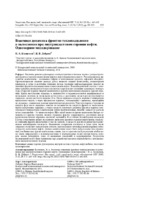| dc.contributor.author | Козначеев, И. А. | |
| dc.contributor.author | Добрего, К. В. | |
| dc.coverage.spatial | Минск | ru |
| dc.date.accessioned | 2019-10-03T12:30:46Z | |
| dc.date.available | 2019-10-03T12:30:46Z | |
| dc.date.issued | 2019 | |
| dc.identifier.citation | Козначеев, И. А. Взаимная динамика фронтов тепловыделения и вытеснения при внутрипластовом горении нефти. Одномерное моделирование = Mutual Dynamics of Heat Dissipation and Oil Displacement Fronts during In-Situ Oil Combustion. One-Dimensional Simulation / И. А. Козначеев, К. В. Добрего // Энергетика. Известия высших учебных заведений и энергетических объединений СНГ. – 2019. – № 5. – С. 445-458. | ru |
| dc.identifier.uri | https://rep.bntu.by/handle/data/57536 | |
| dc.description.abstract | Численно решена одномерная осесимметричная и плоская задача о распространении фронтов горения и вытеснения нефти в нефтенасыщенном пласте. Рассматривались две горючие компоненты – подвижная (нефть) и неподвижная (кероген, нефтяной абсорбат). Проанализировано влияние расхода дутья, вязкости жидкой компоненты, концентрации кислорода в дутье и величины тепловых потерь (толщина нефтесодержащего пласта) на динамику фронтов тепловыделения и вытеснения нефти. В цилиндрической системе с течением времени уменьшается поток окислителя и происходит смещение максимума температуры от фронта горения твердой компоненты к фронту вытеснения («прыжок» фронта горения). Время наступления «прыжка» в зависимости от параметров может варьироваться от нескольких десятков до нескольких сотен суток, а расстояние, на которое осуществляется «прыжок», может достигать порядка 10 м. После «прыжка» скорость горения и температура продолжают падать и через промежуток времени, соизмеримый с временем, прошедшим до «прыжка», химическая реакция практически прекращается. При этом переход горения на жидкую фазу после «прыжка» заметно не сказывается на скорости фронта ее вытеснения. Время наступления «прыжка», а также скорость взаимного удаления фронтов горения (максимальной температуры) и вытеснения нефти приблизительно линейно зависят от расхода дутья и нелинейно – от вязкости нефти. При малой вязкости фронт вытеснения быстро отдаляется от фронта горения, момент «прыжка» фронта задерживается, расстояние между фронтами на момент «прыжка» достигает значений в 10 м и более. Концентрация кислорода в дутье существенно влияет на взаимное движение фронтов горения и вытеснения, поскольку динамика фронта вытеснения от нее не зависит, а скорость фронта горения пропорциональна концентрации кислорода. Повышение содержания кислорода в дутье сразу после «прыжка» позволяет локализовать область максимального тепловыделения (горения) вблизи фронта вытеснения нефти. Данная манипуляция может быть использована для управления устойчивостью фронта вытеснения, однако для ее практической реализации необходимо иметь информацию о концентрационных и температурных полях внутри пласта, которую можно почерпнуть лишь из косвенных измерений и моделирования. Результаты исследований могут быть применены при разработке проектов нефтедобычи c использованием внутрипластового горения. | ru |
| dc.language.iso | ru | ru |
| dc.publisher | БНТУ | ru |
| dc.title | Взаимная динамика фронтов тепловыделения и вытеснения при внутрипластовом горении нефти. Одномерное моделирование | ru |
| dc.title.alternative | Mutual Dynamics of Heat Dissipation and Oil Displacement Fronts during In-Situ Oil Combustion. One-Dimensional Simulation | ru |
| dc.type | Article | ru |
| dc.identifier.doi | 10.21122/1029-7448-2019-62-5-445-458 | |
| local.description.annotation | One-dimensional axis-symmetrical and plane-symmetrical problem of propagation of the combustion and displacement fronts in oil-containing layer in situ has been considered numerically. Two combustible components, viz. liquid (oil) and solid (kerogen, oil sorbate), were considered. The influence of the blast rate, liquid component viscosity, oxygen concentration in blasted air and heat losses (the width of the oil-containing layer) on the dynamics of the heat dissipation and displacement fronts is investigated. In the cylindrical system the oxidizer flow to the combustion front is reducing over time; and the shift-down of the maximum temperature from the solid combustion front to the oil displacement front takes place (the combustion front “jump”). The time of the “jump” may vary from tenths to hundreds of days and the distance of the shift, – up to 10 or more meters, depending on the parameters of the system. After the “jump”, the combustion rate and maximum temperature continue to deteriorate and after the period of time close to the time lapse before the “jump” the chemical reaction ceases. Herewith the transition of combustion to the liquid phase after the “jump” doesn’t influence notably on oils displacement front speed. The time of the “jump”, as well as the velocity of the mutual combustion (maximum temperature) front and displacement front removal nearly linearly depends on incoming gas blast rate and non-linearly – on oil viscosity. When viscosity is low, the displacement front rapidly runs away from the combustion front, time of the “jump” retards and the distance between the fronts at the instance of the “jump” may reach 10 m or more. The oxygen concentration in the gas being blasted influences significantly on the mutual dynamics of the combustion and displacement fronts since combustion front velocity is proportional to oxygen concentration and displacement front velocity is independent on it. Oxygen enrichment of the gas being blasted just after the “jump” may help localize the area of heat release (combustion) near the oil displacement front. The mentioned manipulation may be utilized for sustainability control of the displacement front. However for its practical implementation it is necessary to have information on concentration and temperature fields inside the layer, which may be obtained from indirect data and via modeling. The results of investigation may be utilized for development of technical projects of oil recovery via in-situ combustion. | ru |

